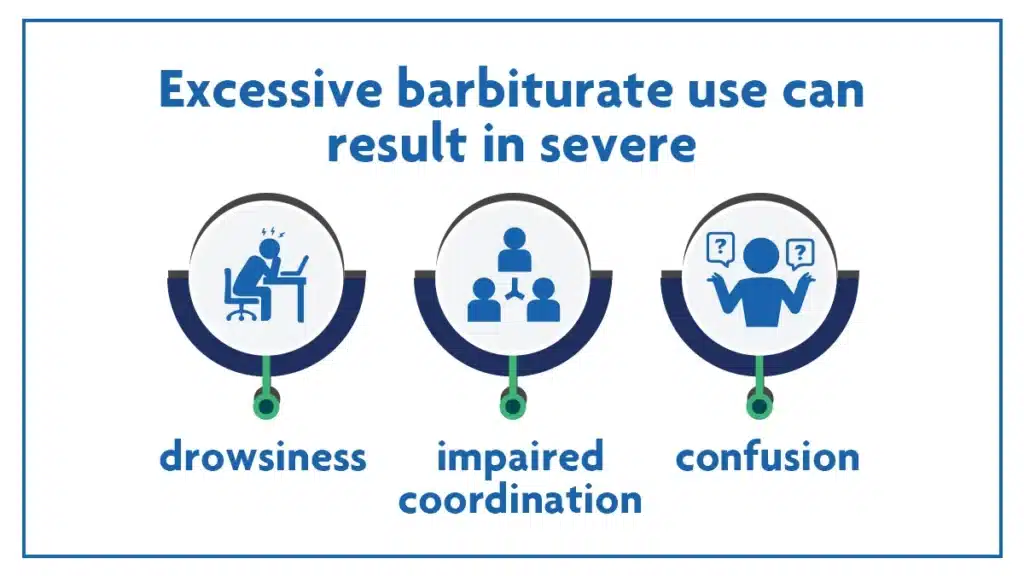Understanding Barbiturates: Uses and Risks
Barbiturates are drugs that impact the central nervous system and are commonly prescribed for anxiety, seizures, or insomnia. They act as depressants, slowing brain activity.
While helpful in medical contexts, misuse can lead to severe consequences. Overuse may result in addiction, respiratory problems, or even fatal overdose.
Parents must be aware that barbiturates pose a risk of abuse, especially among teens seeking a quick escape. Open communication and education about these sedatives are essential to prevent misuse and promote a safer understanding of prescription medications within families.
Key Takeaways
Barbiturates are a class of drugs that affect the central nervous system. Here’s what you need to know:
- Barbiturates, synthesized in the early 20th century, were initially hailed as revolutionary sedatives and anxiolytics.
- Excessive barbiturate use can result in severe drowsiness, confusion, and impaired coordination.
- Overuse or misuse of barbiturates may slow down breathing, posing a risk of respiratory failure, a severe and potentially fatal condition.
- If someone is using barbiturates and experiences symptoms, it’s vital to seek help immediately.
Our teen treatment center provides a supportive environment where adolescents can heal and grow against addiction. Contact us at (845) 479-6888, and let us foster lasting positive change in teens.
Barbiturates: An Overview
Barbiturates, synthesized in the early 20th century, were initially hailed as revolutionary sedatives and anxiolytics. By the mid-20th century, these drugs gained popularity, reaching their peak in the 1950s and 1960s. However, due to their high potential for abuse and overdose, medical use declined.
Some statistics reveal that by the 1970s, barbiturate-related deaths were a severe concern, prompting stricter regulations. Today, their medical use is limited, replaced by safer alternatives. Still, awareness is essential as misuse persists, especially among adolescents.
Despite their diminished use, parents need to learn the risks associated with barbiturates to support their children. Misuse can lead to severe consequences, so education is vital to preventing harm.
Barbiturates are synthetic drugs created in laboratories. Their main ingredient, barbituric acid, is synthesized from malonic acid and urea. The process involves chemical reactions that transform these compounds into a substance with influential properties.
Various formulations and modifications result in different types of barbiturates, each with specific medical uses. These drugs were initially developed as alternatives to existing medications, aiming to provide improved therapeutic effects. However, their production requires careful control and precision due to potential toxic side effects.
Today, many barbiturates have been replaced by safer medications, as they carry a risk of dependence and overdose. Parents need to be aware of the origins of barbiturates, understanding that these drugs are not natural substances but human-made chemicals with significant consequences if misused by their teens.
How Do They Work on the Body
Barbiturates impact the brain and central nervous system by enriching the activity of a neurotransmitter called gamma-aminobutyric acid (GABA). GABA’s role is to inhibit or calm nerve activity in the brain.
Barbiturates increase GABA’s inhibitory effects, leading to a general slowdown of brain function. While this may help in medical conditions requiring sedation, the adverse side effects are notable.
Excessive barbiturate use can result in severe drowsiness, confusion, and impaired coordination. The relaxing effect can extend to the respiratory system, causing slow and shallow breathing and posing a respiratory failure risk.
Additionally, barbiturates can lead to dependence, where a body becomes reliant on the pill to function normally. Abrupt cessation can trigger withdrawal symptoms, including anxiety and seizures.
Different Types of Barbiturates
Barbiturates come in various forms, each designed for specific medical purposes. Some common types include:
Phenobarbital: Phenobarbital is one of the oldest and most widely used barbiturates. It’s primarily prescribed to treat seizures and is known for its long-lasting effects.
Pentobarbital: Often used as a short-acting sedative, it may be employed in medical procedures, such as anesthesia induction.
Secobarbital: This pill is known for its intermediate duration of action and is prescribed to alleviate insomnia. It helps teens fall asleep faster and enhances the quality of sleep.
Butabarbital: It is used for its calming and hypnotic properties. Butabarbital is sometimes prescribed for short-term insomnia relief.
Amobarbital: This barbiturate is used in some medical settings. It is used to induce sleep or as a preanesthetic to reduce anxiety before surgery.
Mephobarbital: Although less commonly prescribed, mephobarbital is another barbiturate with calming properties. It is widely used due to its ability to induce a calming effect.
Learning the specific purpose for which each barbiturate is prescribed helps prevent misuse or accidental overuse. Additionally, healthcare providers carefully consider the choice of barbiturates based on the patient’s medical condition, stressing the importance of using these medications only under professional guidance.
Medical Uses of Barbiturates
Barbiturates are medically used for specific purposes under careful supervision. Phenobarbital, for instance, is prescribed to control seizures in conditions like epilepsy. Its long-lasting effects make it influential for maintaining a consistent level in the body.
For short-term relief of insomnia, healthcare providers may prescribe secobarbital or amobarbital. These barbiturates help teens fall asleep faster and improve sleep quality. They are, however, recommended only for brief periods due to the risk of dependence.
Pentobarbital, with its short-acting nature, finds use in medical procedures as an anesthetic. It induces a state of unconsciousness, ensuring patients are unaware and pain-free during surgery.
In certain situations, butabarbital or mephobarbital might be prescribed for their soothing properties, offering a calming effect. Parents must understand that these medications should only be used for teens as directed by a healthcare professional.
Risk and Side Effects
Barbiturates, though once widely used for medical purposes, pose notable risks and side effects. They often cause excessive sleepiness, affecting teenagers’ ability to stay alert and focused. These medications can hinder motor skills, leading to difficulty in tasks requiring precise movements.
Overuse or misuse of barbiturates may slow down breathing, posing a risk of respiratory failure, a severe and potentially fatal condition. Regular use of drugs can lead to physical and psychological dependency, where the body relies on the drug to function normally.
Abruptly stopping barbiturate use can trigger withdrawal symptoms, including anxiety, insomnia, and seizures. Continued use may result in the need for higher doses to fulfill the same effects, increasing the risk of overdose.
Barbiturates can impact memory and cognitive function, affecting academic or work performance. Nausea and vomiting are potential side effects impacting the digestive system.
Open communication with healthcare experts is vital to ensure proper understanding. Monitor your teens when they use barbiturates to seek early intervention.
Withdrawal Symptoms of Barbiturates
Parents need to learn about barbiturate withdrawal symptoms, as discontinuing these medications can lead to various physical and emotional challenges for their teens. The potential effects teens may experience during the withdrawal process:
Anxiety: Withdrawal from barbiturates can trigger heightened feelings of nervousness and unease.
Insomnia: Teens may face difficulty falling or staying asleep, which is a usual withdrawal symptom affecting overall well-being.
Seizures: Abrupt cessation may lead to seizures, a severe medical complication that requires immediate attention.
Nausea and Vomiting: Gastrointestinal cues like nausea and vomiting are expected during withdrawal.
Muscle Pain: Teens may experience muscle aches and pains as their body adjusts to the absence of the drug.
Tremors: Shaking or tremors in the hands or other body parts can occur during withdrawal.
Hallucinations: Some may experience vivid sensory perceptions not rooted in reality.
Irritability: Irritability and agitation are common emotional responses during withdrawal.
Family support is necessary, especially for teens seeking professional guidance when discontinuing barbiturate use. Medical supervision is vital to manage and mitigate these potentially severe effects in teens.
Symptoms of Overdose

Barbiturates demand a keen awareness of the vivid signals indicating an overdose. Learning these symptoms can be a key factor in seeking timely medical assistance to address potential life-threatening situations of teens.
Drowsiness or Unconsciousness: Barbiturate overdose can lead to extreme drowsiness, making it difficult for a teenager to stay awake or conscious.
Slow or Shallow Breathing: Respiratory depression is a critical symptom where breathing becomes slow and may not provide enough oxygen to the body.
Confusion: Overdose can cause confusion, disorientation, and impaired cognitive function.
Weakness or Fatigue: Teenagers may experience extreme weakness or fatigue as the body struggles to function under excessive barbiturates.
Slurred Speech: Barbiturate overdose often results in slurred or incoherent speech patterns.
Impaired Coordination: Motor skills may be severely affected, leading to stumbling, lack of balance, or difficulty moving.
Coma: In severe cases, overdose can induce a state of unconsciousness known as a coma.
Seizures: Uncontrolled muscle activity, or seizures, may occur as a result of barbiturate overdose.
Barbiturate overdose is a medical emergency requiring immediate attention. Seeking professional help in the United States is vital to address the potentially scary effects of an overdose.
When to Seek Help
If someone is using barbiturates and experiences symptoms like drowsiness, confusion, or slowed heart rate, it’s vital to seek help immediately. It is especially true when the medicine is taken in addition to recreational drugs, intensifying the potential effects and risks.
If family members notice these signs or suspect possible drug interactions, reaching out for information and support is essential for early intervention.
Barbiturate use disorder may develop, leading to withdrawal symptoms when the desired effect diminishes. Joining support groups can provide valuable guidance for teens or families navigating the challenges associated with this group of drugs in the United States.
Frequently Asked Questions (FAQ)
What drugs are considered barbiturates?
Barbiturates are drugs that depress the CNS, causing relaxation and sleepiness. Common names include phenobarbital and secobarbital.
Doctors prescribe them for epilepsy and sleep disorders, but misuse can lead to serious health risks, including addiction and overdose. These drugs can be harmful when combined with alcohol or other substances. Abuse can result in slowed breathing and even death.
Parents must educate teens about the risks, as barbiturate abuse is a serious concern. If you have concerns about prescription drug use, talk openly with healthcare providers to ensure safe and proper use.
What are the potential side effects and risks of using Barbiturates?
Barbiturates are a class of drugs prescribed by doctors that have potential adverse effects on the CNS (central nervous system). Long-acting barbiturates, used in the treatment of epilepsy, can lead to physical dependence and sedative effects.
High doses, especially in liquid form or in combination with alcohol, pose risks like slowed heart rate and muscle weakness. Babies born to mothers using barbiturates may experience withdrawal. Common barbiturates, ultrashort-acting or newer drugs, carry dangers of substance abuse and drug interactions.
It’s also essential for pregnant women to avoid barbiturates and seek medical care for detox if necessary, as well as for teens. Medical professionals can guide families through these potential dangers.
How are barbiturates different from Benzodiazepines?
Barbiturates and Benzodiazepines are both drugs that affect the central nervous system. Barbiturates act as sedatives and can be risky, as even a tiny dose can lead to an overdose.
Benzodiazepines, on the other hand, are safer in terms of overdose risk. They’re prescribed for anxiety, but misuse can lead to dependence.
Barbiturates are older and less common today due to their high risk. Benzodiazepines, like Xanax and Valium, are more widely used.
Both can be habit-forming, but sudden withdrawal from barbiturates can be dangerous, while Benzodiazepine withdrawal is managed more safely. It’s important to use prescription medications as directed.
Where Teens Get a Sober Life
Our teen treatment center is a haven that fosters transformative healing for teens grappling with addiction.
Our barbiturate treatment features engaging educational workshops and rejuvenating holistic therapies to recover teens. Our residential program ensures a supportive environment for recovery, blending individualized counseling and empowering group therapy. No matter the substance challenge, be it barbiturates, opioids, or others, we craft a unique path to sobriety.
It is time to light up your teen’s path toward recovery. Contact (845) 479-6888 and embark on the journey today.


